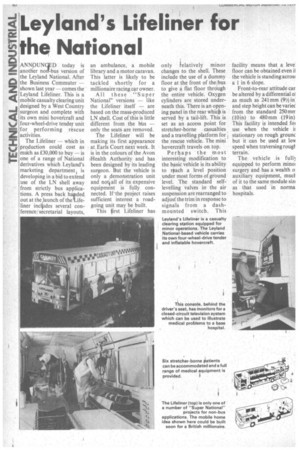Leyland's Wenner for the National
Page 62

If you've noticed an error in this article please click here to report it so we can fix it.
ANNpUN4D today is another no -bus version of the Leyland National. After the Business Commuter — shown last year comes the Leyland Lifeliner. This is a mobile casualty clearing unit designed by a West Country surgeon and complete with its own mini hover'craft and four-wheel-drive tender unit for performing rescue activities.
The Lifeliner — which in Production could cost as much as £30,000 to buy is one of a range of National derivatives which Leyland's marketing department is developing in a bid to extend use of the LN shell away from strictly bus applications. A press back ha:tided out at the launch of the 'Lifeliner inclpes several conference/secretarial layouts, an ambulance, a mobile library and a motor caravan. This latter is likely to be tackled shortly for a millionaire racing car owner.
All these "Super National" versions — like the Lifeliner itself — are based on the mass-produced LN shell. Cost of this is little different from the bus — only the seats are removed.
The Lifeliner will be making its first appearance at Earls Court next week. It is in the colours of the Avon }Health Authority and has been designed by its leading surgeon. But the vehicle is only a ,demonstration unit and noti all of its expensive equipment is fully connected. If'the project raises sufficient interest a roadgoing unit may be built.
This first Lifeliner has only relatively minor changes to the shell. These include the use of a dummy floor at the front of the bus to give a flat floor through the entire vehicle. Oxygen cylinders are stored underneath this. There is an opening panel in the rear which is served by a tail-lift. This is set as an access point for stretcher-borne casualties and a travelling platform for the rescue vehicle. The mini hovercraft travels on top.
Perhaps the most interesting modification to the basic vehicle is its ability to reach a level position under most forms of ground level. The standard selflevelling valves in the air suspension are rearranged to adjust-the trim in response to signals from a dashmounted switch. This • facility, means that a leve floor can be obtained even ii the vehicle is standing acros a 1 in 6 slope.
Front-to-rear attitude car • be altered by a differential a as much as 241 mm (91/2 in and step height can be variec from the standard 250 rnrr • (10in) •to 480 mm (19 in) This facility is intended foi use when the vehicle stationary on rough• grounc but it can be used at lovi • speed when traVersing roue terrain. The vehicle is full', • equipped to perform mina surgery and has a wealth o • auxiliary equipment, muck of it to the same module sizi as that used in norma hospitals.




























































































































































































































